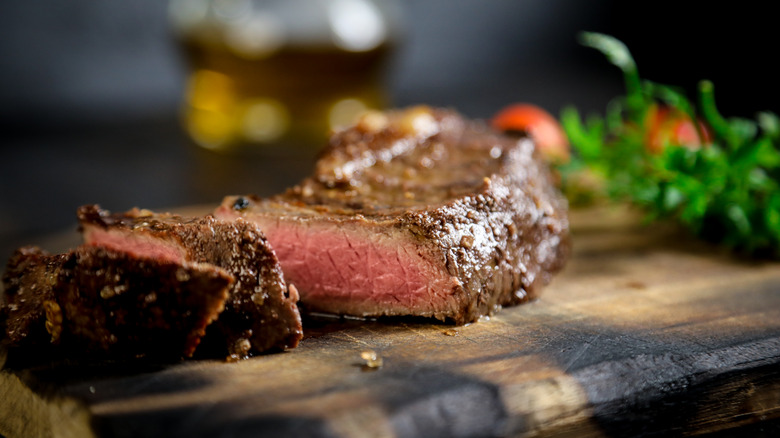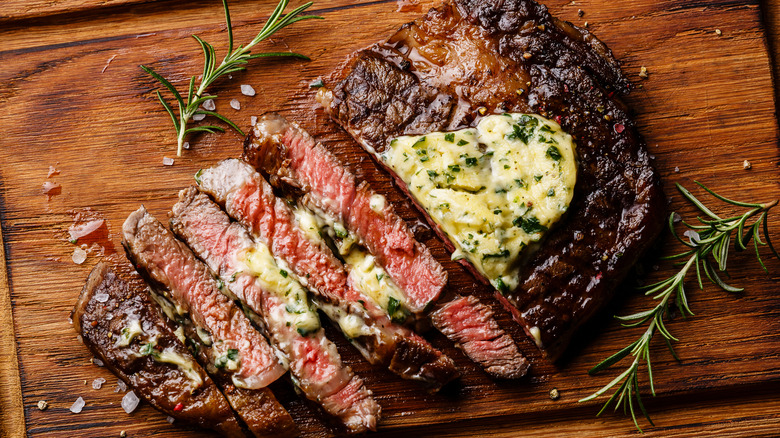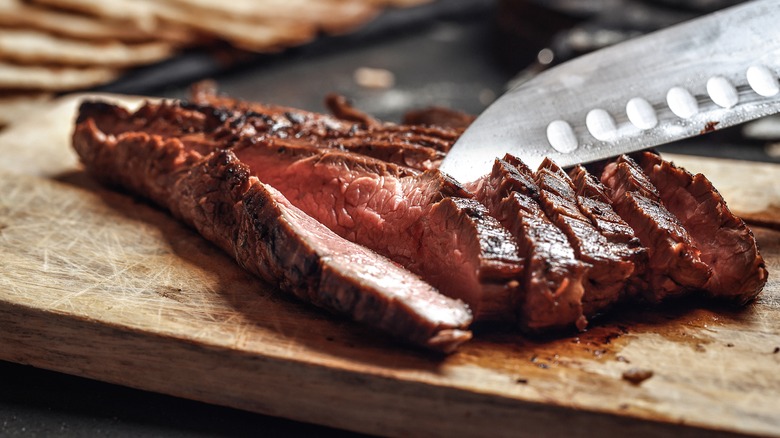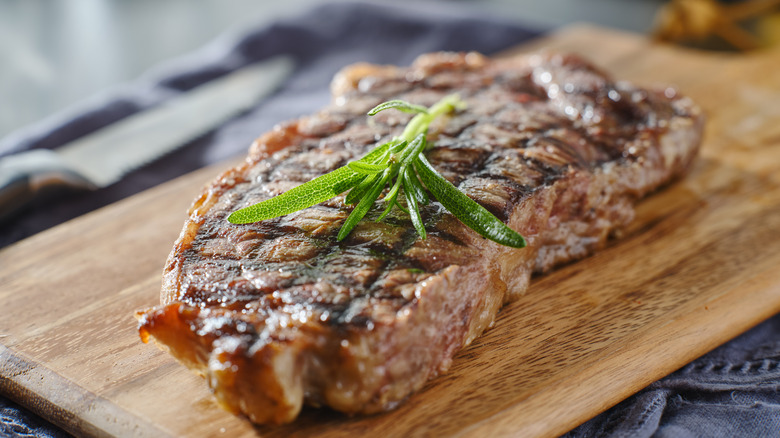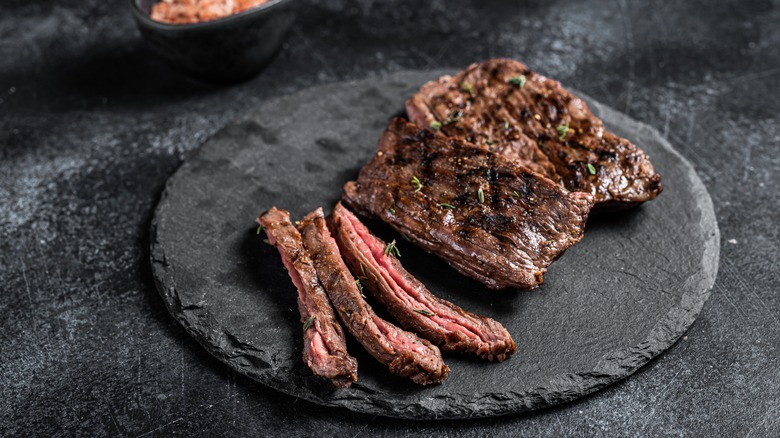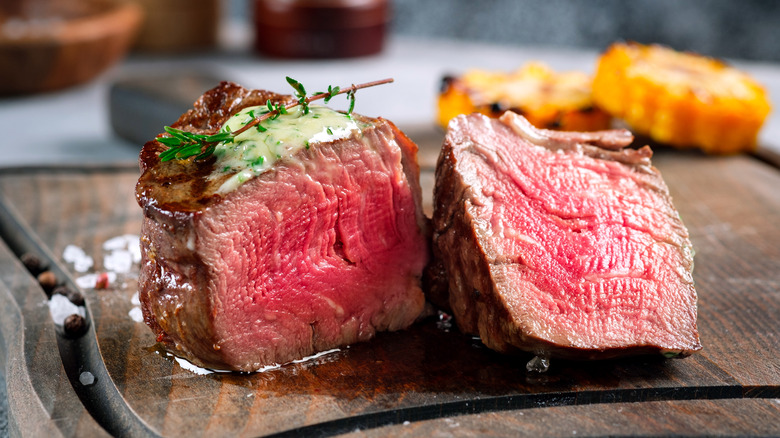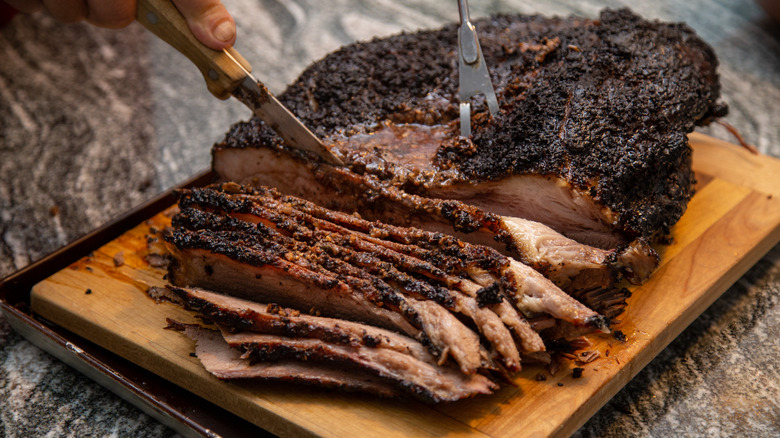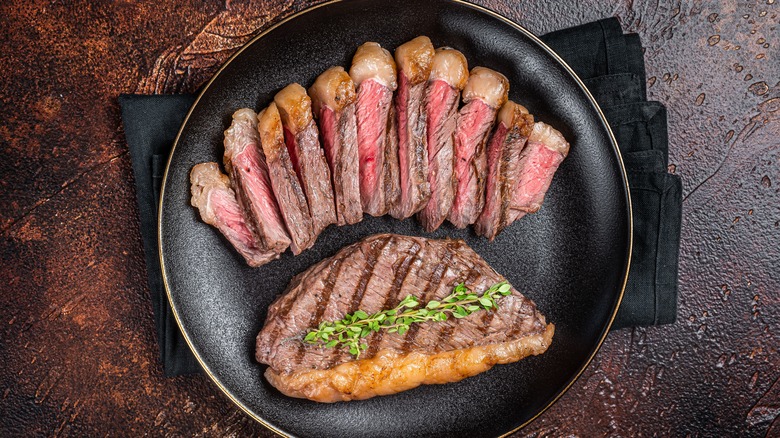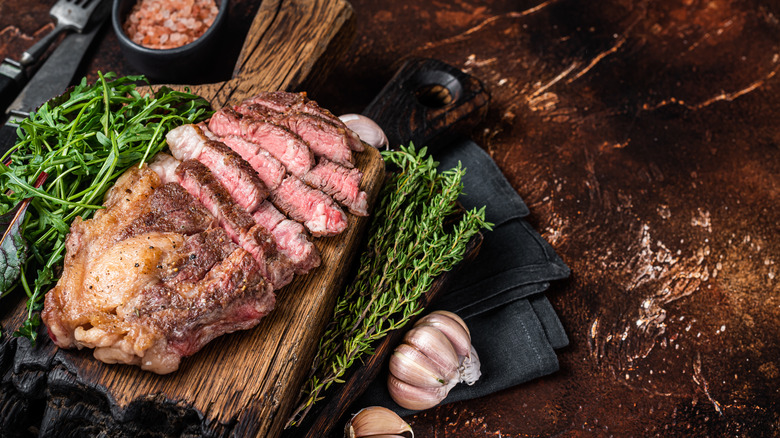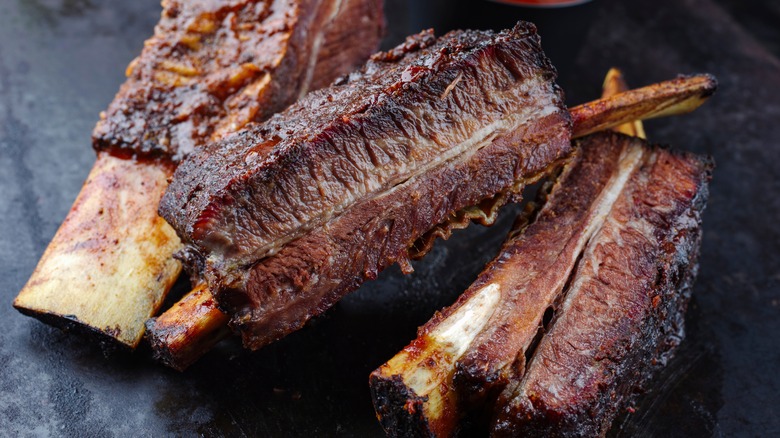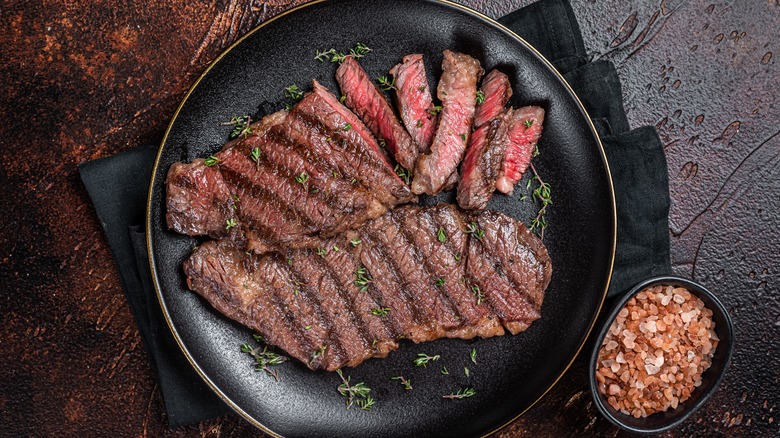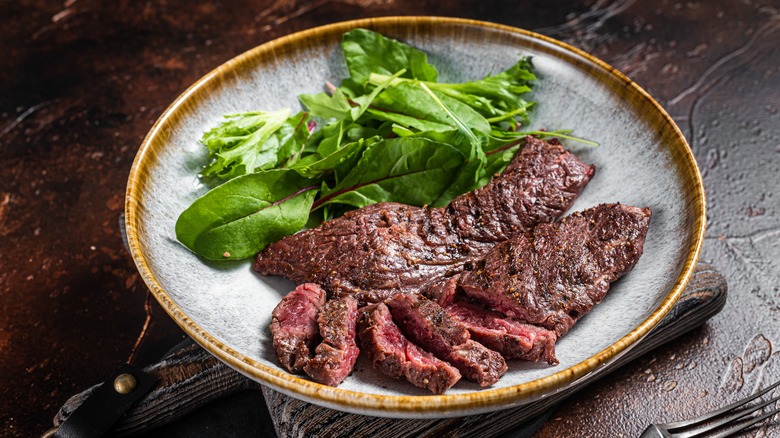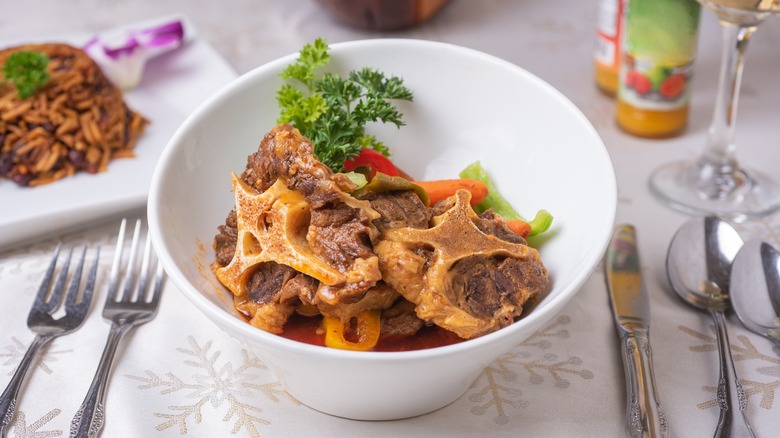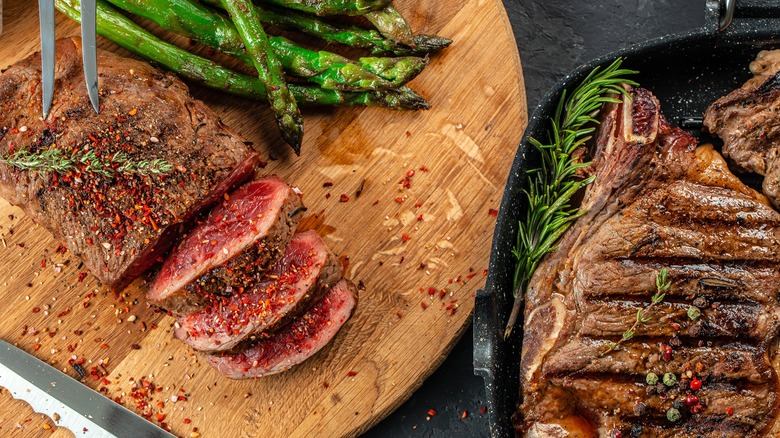Experts Share The Easiest (And Most Difficult) Cuts Of Steak To Cook At Home
A well-cooked steak is a thing of beauty: cooked to the perfect doneness, a crunchy sear on the exterior, melt-in-your-mouth tender. We might take it for granted, but actually achieving this level of perfection is a true feat and not even the best restaurants get it right every single time. As a home cook, it can be even harder to cook the perfect steak.
Which cooking method do you use, and how do you know if the steak is finished without cutting it? Before you can get into these questions, you have to pick which cut of steak you'll be cooking — and some cuts are easier to cook than others.
To start you on the right foot, we asked four experts what they think are the easiest and most difficult cuts of steak to cook at home. Contributing their opinions are Dennis Littley, a fine dining chef with over 40 years of experience and owner of askchefdennis.com and from Justin Owens, co-owner of Manzo Piedmontese, a luxury beef company based in Washington. We also speak Chef Kylian Goussot, the culinary maestro behind Miami's Lafayette Steakhouse and renowned restaurateur and cookbook author, Bricia Lopez of James Beard award-winning restaurant, Guelaguetza.
For these chefs and kitchen professionals, determining whether a steak is easy or difficult comes down to a few different aspects. Sometimes, the most limiting one is time. All experts seemed to agree, however, that just because a steak is difficult doesn't mean you shouldn't give it a try.
Easiest: Ribeye
A ribeye steak is a classic on any steakhouse menu, known as a fatty and flavorful cut. The ribeye comes from the rib area of the cow, between the shoulder and the loin. In addition to being fatty and flavorful, though, it's also forgiving, according to Dennis Littley, a fine dining chef with more than 40 years of experience. Even if you overcook a ribeye by a smidge, he said, the fattiness of the cut will help ensure that you don't end up with a dry hunk of meat that's more akin to cardboard than steak. (Though, using a meat thermometer can help you avoid any overcooking, and you should have one on hand when cooking steak anyway).
Chef Kylian Goussot of Miami's Lafayette Steakhouse recommends looking for a 16-ounce ribeye, saying, "This weight is perfect, because it provides a single portion with an optimal thickness." So, how should you go about cooking your ribeye, if you choose this cut?
Littley advises this: "For ribeye, I recommend grilling or using a hot skillet. Season it generously with salt and pepper. Sear each side for about three to four minutes, until you get a nice crust, and then cook it to your desired doneness. Medium-rare is usually a good bet."
Most difficult: Flank steak or bavette
You might be tempted to cook a flank steak, especially when you're perusing the meat aisle at your grocery store and you see that it's one of the more affordable cuts of steak you could buy. However, the steak isn't surefire. This cut — sometimes also referred to as "bavette" in French — is notoriously tough, and one that several chefs told us inexperienced home cooks should stay away from if they're looking to avoid the risk of an improperly cooked steak.
The chief issue that Justin Owens of Manzo Piedmontese notes it that this cut will cook quicker and be less forgiving because its on the thinner side. Most steak pros agree that a "thick" cut is going to be between 1½-2-inches; the average flank will is between ¾ to 1-inch. Plus, it lacks marbling, which is greats the lubrication needed to keep a steak moist.
If you do want to try your hand at a flank steak, there is a lot of advice out there for getting it right. Dennis Littley says it all comes down to cooking the steak quickly and slicing it properly. If you slice it against the grain, that will help minimize the toughness. Yo might even try pro the 3-3-2-2 method for perfectly searing your steak: Sear one side for three minutes, flip, and go for the same amount of time. Then, repeat the process but for two minutes on either side. (Don't forget to rest for five.)
Easiest: Strip steak
You can call this cut of steak by many names: strip steak, New York strip, strip loin steak, Omaha strip, Kansas City strip, and more. Whatever you call it, though, one thing's for certain: This is a pretty easy cut of steak to cook, and one of the best for new home cooks to take on. Cut from the loin area of the cow, strip steaks are known to be tender and flavorful.
Cooking this cut is pretty straight-forward, and chef Dennis Littley recommended that you use a cooking process similar to what you might use for a ribeye. Sear the steak on both sides in a hot skillet (cast iron is a good choice), with a bit of oil, and then, if it's a thicker cut, finish the steak off in the oven until it hits you're desired doneness.
If you want a medium-rare steak, you'll want to go for an internal temperature of 130 degrees Fahrenheit. After the steak reaches that temperature, though, you're work's not finished just yet. Littley reminds us that even with easier steak cuts to cook, you need to allow the meat to rest after cooking. The juices to redistribute, making for a supple bite.
Most difficult: Skirt steak
Both Dennis Littley and Justin Owens name skirt steaks as one of the more difficult cuts of steak to cook. According to Littley, the common pitfalls will result in your steak becoming something that requires a lot of chewing. Unfortunately for the uninitiated, there are a several reasons why skirt steaks are notoriously difficult.
For one, the steak is filled with lots of connective tissue, which can make it tough. Plus, there are two types of skirt — inside and outside skirt steaks — though both are taken from two muscles below the cow's ribs. The difficult thing about skirt steaks is that yours might be cut from the less-tender side. Outside skirt steak often has a membrane, or silver skin, which may or may not be removed for you by the butcher. If it's not, you have to try your hand at cutting it and this might result in yield loss. Furthermore, skirt steaks are thin, so they're very easy to overcook.
Because of this, if you do decide to cook a skirt steak, you'll want to do so over very high heat, very quickly, and to no greater doneness than medium rare. One way to insulate yourself from overcooking is to use a dry brine or wet marinade. Just like with a flank steak, you'll need to cut a skirt steak against the grain, and it should be cut before serving.
Easiest: Filet mignon
Filet mignon has the reputation of automatically leading home cooks think of fancy foods, because filet mignon is considered a higher-end cut associated to steakhouses. Of course it's going to be difficult to cook, maybe even better left to the pros?
For anyone new to grilling, it's time to revise how you think about filet mignon. This cut is very easy to cook. Taken from the end of the tenderloin, filet mignon is as popular as it is specifically because it's ultra-tender and exceptionally flavorful, but also simple to work with. "Yes, it's on the pricier side," says Denise Littley, "but its tenderness makes it a breeze for beginners to handle without worrying too much about toughness."
Littley suggests searing your filet mignon in a hot pan, for two to three minutes per side, and then finishing it in the oven. Again, aim to cook the filet mignon to a doneness of about medium rare, or 135 degrees Fahrenheit.
Apart from overcooking, which denatures the proteins into something tough, a filet that's been pre-tenderized too much might can cause problems for home cooks. If you've cooked your steak so that it has a charred edge and pink insides, but feels mushy, talk to your butcher. If they've used a jaccard on the meat you want to avoid any extra tenderizing or marinating. You should barely need a knife to eat a well-cooked, quality filet mignon.
Most difficult: Brisket
Every expert we spoke to said that brisket was a difficult cut of steak to cook, which might surprise you, given that brisket is pretty popular. You can get it at just about any barbecue restaurant, or even at your neighborhood Chipotle. However, this is a very large cut that can sometimes weigh near 15 pounds, and it needs multiple hours to cook. Finding the time to cook brisket is probably one of the most difficult aspects of this cut.
Dennis Littley notes that brisket contains connective tissues, especially collagen, and that need to be broken down. When it's done slowly, the multiple hours of cooking that are required makes the collagen an important par of the process, because it turns to gelatin. Not long enough, and the brisket will be tough and dry. This is not a cut of beef that you can throw on the grill for an impromptu barbecue. So, if you have a craving for a brisket sandwich, you need to put it in the calendar. Littley says, "Keep the temperature low and steady, and give it plenty of time — several hours at least — to ensure it becomes tender."
Easiest: Top sirloin cap
You don't have to stick with the same-ol' familiar cuts like ribeye and New York strip if you want to cook an easy steak at home. As Justin Owens says, "Something a little more out of the box to learn on could be coulotte, or top sirloin cap." Also called picanha, whatever you name it, the cut is boneless, narrow, lean, and on the long side. It's taken from the sirloin tip, and comes with a fatty cap.
Because it has such prominent fat, one look at top sirloin makes it appear easy to cook. But all of the fat is in the top, and little is in the muscle. Top sirloin can actually be a difficult steak to cook, which is why Owens recommends a unique cooking method for beginners: sous vide.
Sous vide offers more control in the process. You can precisely mark the temperature of your steak, allowing you to reach your exact desired level of doneness without risking overcooking. Because overcooking something without marbling to can happen with this steak.
Owens notes that you should follow the sous vide with the reverse sear method. However, when reverse searing, he reminds us that there's a risk of overcooking, so hit it hot and fast. "Don't be afraid to make a mistake," he says. "You can always adjust and try again.
Most difficult: Chuck
Chuck steak might be cheap, but it shouldn't be your first pick at the grocery store if you're new to cooking steak. Sometimes called "the poor man's ribeye," there's a big difference in cooking these two cuts. According to restaurateur and cookbook author Bricia Lopez, chuck can be more challenging just like brisket, due to the cut's dense muscle fibers. As such, it requires slower cooking times in order to achieve a level of tenderness.
If, though, you do want to cook chuck rather than ribeye (the cost difference is attractive), Lopez has some tips. First, choose USDA Prime beef, as these cuts will have a higher fat content. Fat is an emollient to the chuck meat, keeping it from drying out during the long cooking time.
Lopez guides us to, "Maintain a steady, low temperature and keep the meat moist." She says that covering the meat can trap moisture as well, which is part of the game with chuck. However you trap in moisture, remember that wetness is the enemy of searing. If you want a crust on your chuck, pat dry and brown it first. You don't want to boil the meat. Still, Lopez advises that you should "Be patience. The slow cooking process is key to transforming tough cuts into the juiciest and most tender bites. Slow and steady wins the race."
Easiest: Short ribs
Short rib goes by many names, because, although the meat comes from the same place, it can be removed through different cuts. Short rib is generally anything that comes from the underbelly of the cow. But whether it's cross-cut (English) or flanken determines whether you'll have bones or not.
In general, Bricia Lopez says that cross-cut short rib is one of the easiest cuts of beef for beginners to cook, as she notes that the cut can be cooked quickly and "the bones add incredible flavor." However, cross-cuts have an entirely different cooking process that is different from what you'd use for steaks, while flanken is more akin to steak preparations.
Lopez recommends marinating flanken ribs before cooking them over high heat, which crisps the edges of the ribs, while ensuring the interior remains tender. She adds, "Consider using USDA Prime for these cuts, as the extra marbling enhances flavor absorption and tenderness. For marinades, a mix of citrus, soy sauce, and spices works well, complementing the natural flavors of the meat." For her own marinades, Lopez says she loves using Lee Kum Kee Panda brand mushroom flavored dark soy sauce, as well as a chili garlic sauce by the same brand.
Most difficult: Denver
The Denver steak might be a bit unfamiliar, and Justin Owens explains why. He includes it in his list of some of the most difficult cuts of steak for beginners to cook, alongside flat iron steaks and skirt steaks.
A Denver steak comes from the cow's shoulder and is similar to a flank steak, but thicker. It might also be called a bottom chuck steak or underblade steak. Like other thin steaks, the Denver steak is often also served in dishes where it might be sliced ahead of time, like on a sandwich, versus being served whole, like a filet mignon.
Despite the challenges, though, if you do try to cook this cut, Owens has advice: "Use high heat in a cast iron pan with extra virgin olive oil or butter. Keep the cook time short; if it's not done enough, you can always put it back in the pan." When you've removed your Denver cut, remember to give it the proper about of time to rest. You should implement one minute of resting time or each minute of cooking and air it out on a raised surface, such as a cooling rack.
Easiest: Flap
Flap steak, also sometimes just called flap meat or bottom sirloin butt, is more affordable than skirt steak, as well as larger than a skirt steak, but the cut still offers some of the qualities that more experienced chefs often look for in a skirt steak. (In fact, industry insiders have been using flap steak for years; it's just the general public that's not as familiar with this cut.) They're also one of Bricia Lopez's easiest option for beginners.
"Flap steaks are excellent choices for beginners, especially for those looking to host a carne asada. They are my go-to! They're forgiving in cooking and flavorful," she says. Lopez adds that you should marinate these cuts, and then cook them over very high heat. Letting them come to room temperature before you sear them ensures that there's no cold spots that could result in uneven cooking. While this is a cut that's often used sliced in dishes like tacos, it can also be served whole.
Most difficult: Tail
While not steak per se, chef Kylian Goussot notes beef tail among his top three most difficult cuts for beginners to cook at home (along with the neck and brisket). It require longer cooking times in order to break down and become tender. Often, he said, they require multiple hours of cooking, but, the longer they cook the better they are — and some are even better the next day. In addition to the actual time under heat, cooking oxtail also should begin with a soaking and blanching period, which are added moments spent attending to this cut.
If you want to put in the work, he does say that it's well worth it. He tells the Takeout, "Make sure you have the time to cook them for hours, or even serve them to your guests the next day. Don't hesitate to plan your preparations in advance." Goussot says that time is the most important thing to remember when cooking tail meat: "My grandmother always told me, 'Good things take time, and they will be remembered.'"
Methodology
To inform this article, we interviewed four steak and culinary experts: Dennis Littley, a fine dining chef with over decade of experience contributed. We also spoke with renowned restaurateur and cookbook author, Bricia Lopez, who is known for her passion of Oaxacan cuisine and a member of Guelaguetza restaurant. Justin Owens, the co-owner of Manzo Piedmontese, a luxury beef company based in Washington, and chef Kylian Goussot, of Miami's Lafayette Steakhouse also contributed.
In general, our contributors to this piece organized their easiest and most difficult cuts by a few things, such as the leanness of a particular cut, or the time it takes to prepare it. Cuts that required more steps or technical knowledge will be a bit harder for first timers, but they are still well worth the effort.
